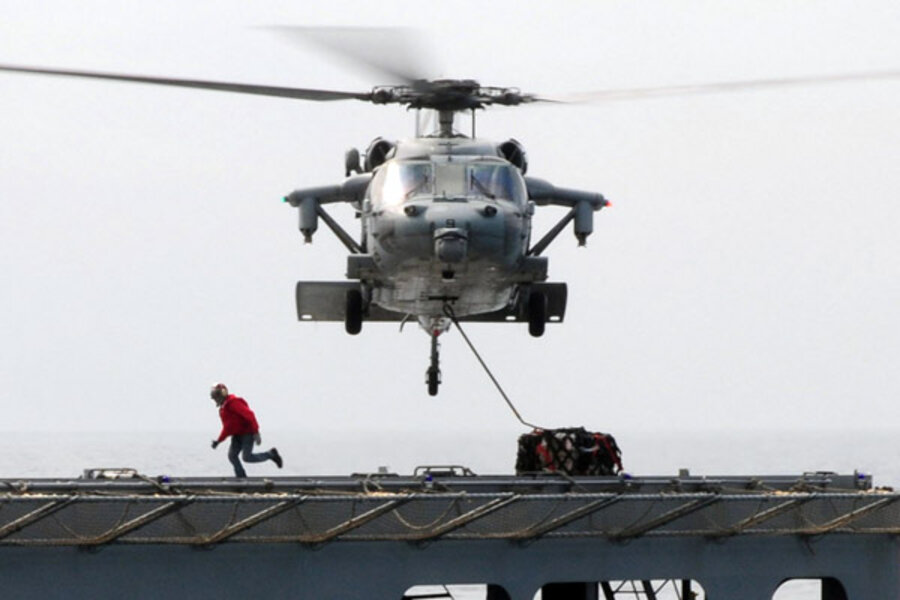Japan nuclear crisis: US Navy monitoring health threat to forces
| Washington
The US military is keeping a watchful eye on the health of US forces in Japan and on radiation levels emitted by Japan’s Fukushima I nuclear power plant as it continues its extensive relief efforts in the wake of the country’s massive 9.0 earthquake and accompanying tsunami.
There is reason for concern among US military officials. Already the US Navy’s 7th Fleet was forced to reposition its ships and aircraft “after detecting low-level contamination in the air and on its aircraft operating in the area,” according to a statement released by the fleet Monday.
In the meantime, the Navy continues to closely measure radiation levels – and ensure that its ships are not downwind from the endangered plant. “We continue to reposition our ships away from what’s known as ‘the plume,’ ” says Palmer Pinckney, chief of public affairs for the US Navy’s 7th Fleet.
RELATED: Japan's nuclear crisis: A timeline of key events
Perhaps the most alarming development is that radiation has also been detected on US troops themselves. Three helicopter air crews – or about 17 US military personnel – returning to the USS Ronald Reagan after taking part in relief operations near the city of Sendai over the weekend were found to have higher-than-normal radiation levels coming from their bodies.
On Tuesday the 7th Fleet said that two military service members aboard the Ronald Reagan were given potassium iodide pills as a precaution after they were exposed to radiation, but that no troops have shown any sign of radiation poisoning. On Wednesday, the fleet said, a number of helicopter crews were given the tablets before flying their sorties, which would take them within 70 nautical miles of the reactors.
“The low-level radioactivity was easily removed from affected personnel by washing with soap and water,” according to the Monday statement, which added that the helicopter crew members returning to the Ronald Reagan “were subsequently surveyed, and no further contamination was detected.”
'Not a cause for alarm'
The US military is seeking to put their levels of exposure in perspective for the remainder of ships’ crews operating in the area.
“It’s important to note that the levels of radiation these air crew members are being exposed to are very, very low and not a cause for alarm,” Mr. Pinckney says. “It is something that we have to watch very carefully and make sure that we are able to monitor and mitigate against.”
According to the statement released by the fleet, “The maximum potential radiation dose received by any ship’s force personnel aboard the ship when it passed through the area was less than the radiation exposure received from about one month of exposure to natural background radiation from sources such as rocks, soil, and the sun.”
Nonetheless, the US military’s plans have been affected by Japan’s escalating nuclear crisis, which “now appears more serious than Three Mile Island,” according to US Secretary of Energy Steven Chu, who gave the assessment in testimony on Capitol Hill Wednesday.
The fleet’s command decided to move the USS Ronald Reagan, along with other 7th Fleet ships conducting disaster response operations in the area, “out of the downwind direction from the site to assess the situation and determine what appropriate mitigating actions are necessary,” according to the statement.
The USS Ronald Reagan was operating about 100 miles northeast of the crippled nuclear power plant at the time of the radiation exposure.
Likewise, the commander of US naval forces in Japan ordered that further precautionary measures for US service members and their families be taken after the USS George Washington, which is docked in Yokosuka, south of Tokyo and some 200 miles from the nuclear plants, “detected low levels of radioactivity” emanating from the Fukushima I nuclear plant.
To this end, the commander ordered that US residents living on bases in Yokosuka and the nearby Atsugi naval air facility limit outdoor activities and keep windows closed and ventilation systems shut “as much as practical.”
Again, the commander endeavored to reassure the base community. “These measures are strictly precautionary in nature. We do not expect that any United States Federal radiation exposure limits will be exceeded even if no precautionary measures are taken.”
Relief effort continues
Even as these warnings were issued, US service members continued the relief mission. Since the earthquake, US troops have delivered more than 25 tons of humanitarian aid – including food, water, and blankets – to some 2,000 people in the affected area and rescued upwards of 752 earthquake survivors, according to Pinckney.
Some politicians questioned whether the Obama administration should risk exposing US troops to radiation for a humanitarian mission. “We’re not going to put any troops in harm’s way,” says Pinckney. He added, too, that “safety is the utmost concern, but the mission has to go on.”
He also stressed the Navy’s experience with nuclear matters. “What’s important here is to understand that no one does this better than the Navy. The Navy knows nuclear,” he adds, “and how to do it safely.”





